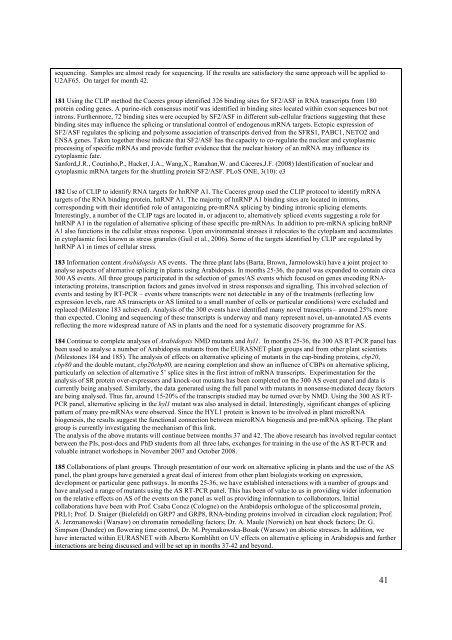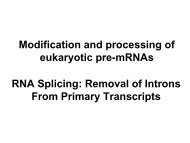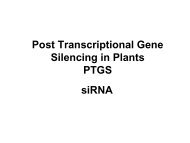Create successful ePaper yourself
Turn your PDF publications into a flip-book with our unique Google optimized e-Paper software.
sequencing. Samples are almost ready for sequencing. If the results are satisfactory the same approach will be applied toU2AF65. On target for month 42.181 Using the CLIP method the Caceres group identified 326 binding sites for SF2/ASF in RNA transcripts from 180protein coding genes. A purine-rich consensus motif was identified in binding sites located within exon sequences but notintrons. Furthermore, 72 binding sites were occupied by SF2/ASF in different sub-cellular fractions suggesting that thesebinding sites may influence the splicing or translational control of endogenous mRNA targets. Ectopic expression ofSF2/ASF regulates the splicing and polysome association of transcripts derived from the SFRS1, PABC1, NETO2 andENSA genes. Taken together these indicate that SF2/ASF has the capacity to co-regulate the nuclear and cytoplasmicprocessing of specific mRNAs and provide further evidence that the nuclear history of an mRNA may influence itscytoplasmic fate.Sanford,J.R., Coutinho,P., Hacket, J.A., Wang,X., Ranahan,W. and Cáceres,J.F. (<strong>2008</strong>) Identification of nuclear andcytoplasmic mRNA targets for the shuttling protein SF2/ASF. PLoS ONE, 3(10): e3182 Use of CLIP to identify RNA targets for hnRNP A1. The Caceres group used the CLIP protocol to identify mRNAtargets of the RNA binding protein, hnRNP A1. The majority of hnRNP A1 binding sites are located in introns,corresponding with their identified role of antagonizing pre-mRNA splicing by binding intronic splicing elements.Interestingly, a number of the CLIP tags are located in, or adjacent to, alternatively spliced events suggesting a role forhnRNP A1 in the regulation of alternative splicing of these specific pre-mRNAs. In addition to pre-mRNA splicing hnRNPA1 also functions in the cellular stress response. Upon environmental stresses it relocates to the cytoplasm and accumulatesin cytoplasmic foci known as stress granules (Guil et al., 2006). Some of the targets identified by CLIP are regulated byhnRNP A1 in times of cellular stress.183 Information content Arabidopsis AS events. The three plant labs (Barta, Brown, Jarmolowski) have a joint project toanalyse aspects of alternative splicing in plants using Arabidopsis. In months 25-36, the panel was expanded to contain circa300 AS events. All three groups participated in the selection of genes/AS events which focused on genes encoding RNAinteractingproteins, transcription factors and genes involved in stress responses and signalling. This involved selection ofevents and testing by RT-PCR – events where transcripts were not detectable in any of the treatments (reflecting lowexpression levels, rare AS transcripts or AS limited to a small number of cells or particular conditions) were excluded andreplaced (Milestone 183 achieved). Analysis of the 300 events have identified many novel transcripts – around 25% morethan expected. Cloning and sequencing of these transcripts is underway and many represent novel, un-annotated AS eventsreflecting the more widespread nature of AS in plants and the need for a systematic discovery programme for AS.184 Continue to complete analyses of Arabidopsis NMD mutants and hyl1. In months 25-36, the 300 AS RT-PCR panel hasbeen used to analyse a number of Arabidopsis mutants from the <strong>EURASNET</strong> plant groups and from other plant scientists(Milestones 184 and 185). The analysis of effects on alternative splicing of mutants in the cap-binding proteins, cbp20,cbp80 and the double mutant, cbp20cbp80, are nearing completion and show an influence of CBPs on alternative splicing,particularly on selection of alternative 5’ splice sites in the first intron of mRNA transcripts. Experimentation for theanalysis of SR protein over-expressors and knock-out mutants has been completed on the 300 AS event panel and data iscurrently being analysed. Similarly, the data generated using the full panel with mutants in nonsense-mediated decay factorsare being analysed. Thus far, around 15-20% of the transcripts studied may be turned over by NMD. Using the 300 AS RT-PCR panel, alternative splicing in the hyl1 mutant was also analysed in detail. Interestingly, significant changes of splicingpattern of many pre-mRNAs were observed. Since the HYL1 protein is known to be involved in plant microRNAbiogenesis, the results suggest the functional connection between microRNA biogenesis and pre-mRNA splicing. The plantgroup is currently investigating the mechanism of this link.The analysis of the above mutants will continue between months 37 and 42. The above research has involved regular contactbetween the PIs, post-docs and PhD students from all three labs, exchanges for training in the use of the AS RT-PCR andvaluable intranet workshops in November 2007 and October <strong>2008</strong>.185 Collaborations of plant groups. Through presentation of our work on alternative splicing in plants and the use of the ASpanel, the plant groups have generated a great deal of interest from other plant biologists working on expression,development or particular gene pathways. In months 25-36, we have established interactions with a number of groups andhave analysed a range of mutants using the AS RT-PCR panel. This has been of value to us in providing wider informationon the relative effects on AS of the events on the panel as well as providing information to collaborators. Initialcollaborations have been with Prof. Csaba Concz (Cologne) on the Arabidopsis orthologue of the spliceosomal protein,PRL1; Prof. D. Staiger (Bielefeld) on GRP7 and GRP8, RNA-binding proteins involved in circadian clock regulation; Prof.A. Jerzmanowski (Warsaw) on chromatin remodelling factors; Dr. A. Maule (Norwich) on heat shock factors; Dr. G.Simpson (Dundee) on flowering time control, Dr. M. Prymakowska-Bosak (Warsaw) on abiotic stresses. In addition, wehave interacted within <strong>EURASNET</strong> with Alberto Kornblihtt on UV effects on alternative splicing in Arabidopsis and furtherinteractions are being discussed and will be set up in months 37-42 and beyond.41







